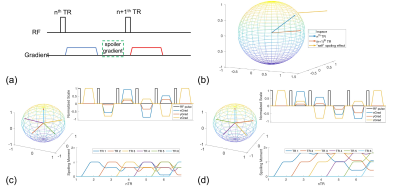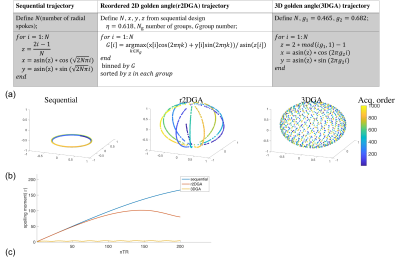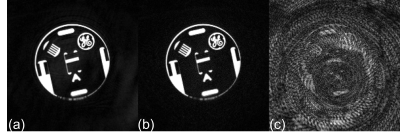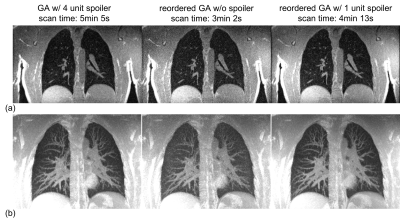3727
Optimizing trajectory ordering for faster small-tip center-out radial gradient echo(GRE)1Radiology and Biomedical Imaging, University of California, San Francisco, San Francisco, CA, United States, 2UC Berkeley-UCSF Graduate Program in Bioengineering, University of California, San Francisco and University of California, Berkeley, Berkeley, CA, United States, 3Medical Physics, University of Wisconsin, Madison, Madison, WI, United States, 4Radiology, University of Wisconsin, Madison, Madison, WI, United States
Synopsis
Center-out sequence has natural spoiling effect, called “self” spoiling. By leveraging this idea, the standard large spoiler gradient could be reduced or removed without sacrificing the image quality. In this study, we investigated how 3D radial trajectory ordering affects spoiling, and proposed a reordered 2D golden angle scheme to maximize “self” spoiling effect and retain robustness to free breathing scan. We evaluated the proposed ordering scheme on both phantom and volunteer. Proposed scheme without or with small spoiler gradient can reduce up to 40% scan time to get comparable image quality.
Introduction
3D center-out type trajectories, which start at the center of k-space, have lots of nice properties, such as shortening minimum echo time(TE) and repeated sampling of the center k-space1 . 3D non-Cartesian center-out trajectories with random or pseudo-random ordering are also widely used in free breathing chest2 and abdominal imaging3,4 , because of their motion incoherent sampling property. The golden angle ordering3,4 acquisition scheme is one of most popular strategies because it samples more uniformly in the k-space temporally compared to other pseudo random methods5. Standard small-tip spoiled gradient echo(GRE) needs an additional spoiler gradient before each subsequent excitation6 . The spoiling moment is usually set to several times larger area than maximum k-space to dephase the residual transverse magnetization from previous TRs. As a result, the total scan time would be elongated. By revisiting the basic GRE sequence Fig.1(a), the spatial encoding gradient can also serve as part of the spoiler gradient, which might reduce the spoiler gradient amplitude and duration, and further speed up the scan.In this work, we proposed a reordering 2D golden angle(r2DGA) scheme to better leverage the “self” spoiling effect, and evaluated it in phantom study and free breathing volunteer lung MRI studies.Methods
“self” spoiling mechanismA basic center-out sequence and its corresponding k-space trajectory are in Fig.1(a,b), where the k-space sampling space is within the mesh sphere. In each TR, k-space sampling starts from center to edge of the k-space boundary. In the next TR, effectively, the previous spatial encoding gradient serves as a natural spoiler gradient, named “self” spoiling, with spoiling moment $$$\pi$$$. In a continuous acquisition, “self” spoiling is affected by trajectory pattern design of adjacent TRs. For instance, two 3D randomly generated sampling patterns with similar k-space coverages are plotted in Fig.1(c) and (d). According to the spoiling moment plots, the more continuous trajectory(d) creates larger spoiling moments in the subsequent TRs compared to random ordering(c).
3D UTE trajectory ordering
In this work, we focus on the small-tip(<6°) center-out radial ultra-short TE(UTE) sequence application. Two major criteria should be considered in trajectory ordering design. Firstly, residual transverse magnetization should be spoiled in the following TRs. Secondly, pseudo-random k-space sampling ordering should be used to tolerate subject motion. We propose a reordered 2D golden angle(r2DGA) scheme to fulfill the two criteria. Firstly, a 3D sequentially sampling pattern is designed. Then, the acquisition orders are binned in different 2D golden angle groups(kx-ky plan). In each group, subgroup spokes are sorted by kz location. Sequential acquisition and 3D golden angle(3DGA) are used for comparison. The pseudo-code for all three schemes are summarized in Fig.2(a).1000 spokes from the full scan(100k spokes) with different sampling schemes are plotted in Fig.2(b), r2DGA scheme more uniformly samples the k-space, compared to sequential scheme, but less uniformly than 3DGA. However, reordered r2DGA scheme has the largest “self” spoiling moments among the three schemes, Fig.2(c).
MRI experiment
Experiments were run on 3T GE Signa 750 (General Electric, Milwaukee, WI) with an 8-channel cardiac coil. An optimized variable density readout center-out radial sequence with 100,000 radial spokes was used in all experiments. For phantom study, data were acquired with isotropic FOV 20cm, image matrix size 200x200x200, TE=100μs, sampling bandwidth=125kHz, image was reconstructed by NUFFT. For volunteer study, data were acquired with isotropic FOV 32cm, image matrix size 256x256x256, image is reconstructed by soft-gated reconstruction7 . For both studies, TRs were varied due to different extra gradient spoiler(1.9~3.7ms), FAs were set to 4~6° accordingly. 3DGA ordering scheme with extra $$$4\pi$$$ spoiling moment spoiler was used as the reference.
Results
Fig.3 shows the comparison of a spoiler gradient free sequence. Compared to 3DGA with spoiler reference scan(a), the r2DGA spoiler free sequence(b) shows comparable image quality, and very slight noise-like artifacts show up due to imperfect spoiling. 3DGA without spoiler gradient(c) has very strong artifacts due to the residual transverse magnetization contamination.Fig.4 shows the effects of different levels spoiling moments on the image with r2DGA ordering. The apparent SNR(aSNR) largely increases when a very small spoiler gradient is added to the sequence, and the previous noise-like artifacts are largely suppressed. As the spoiler gradient moment increases, aSNR slightly increases, however the total scan time(TA) largely increases. Line profiles(red dash line in (a)) from each scan are plotted in (b). With the proposed ordering, spoiler gradient could be largely reduced by leveraging the “self” spoiling.
Fig.5 shows the volunteer studies. The r2DGA scheme without spoiler can reduce 40% scan time to get comparable image quality compared to the reference in (a), however, some small structures are invisible in maximum intensity projection(MIP), (b). By adding $$$\pi$$$ moment spoiler gradient, the noise-like artifacts are suppressed in (a) and smaller vessels could be delineated even compared to reference. In addition, 20% less scan time is required compared to the reference scan.
Conclusion
In this study, we proposed a new ordering scheme for 3D center-out radial trajectory leveraging “self” spoiling effect to reduce or remove spoiler gradient. The proposed reordered 2D golden angle ordering without or with small spoiler gradient can reduce up to 40% scan time but get comparable image quality.Acknowledgements
This work is supported by NIH grant R01 HL136965.References
[1] Pipe, J. G. (1999). An optimized center‐out k‐space trajectory for multishot MRI: comparison with spiral and projection reconstruction. Magnetic Resonance in Medicine: An Official Journal of the International Society for Magnetic Resonance in Medicine, 42(4), 714-720.
[2] Johnson, K. M., Fain, S. B., Schiebler, M. L., & Nagle, S. (2013). Optimized 3D ultrashort echo time pulmonary MRI. Magnetic resonance in medicine, 70(5), 1241-1250.
[3] Feng, L., Grimm, R., Block, K. T., Chandarana, H., Kim, S., Xu, J., ... & Otazo, R. (2014). Golden‐angle radial sparse parallel MRI: combination of compressed sensing, parallel imaging, and golden‐angle radial sampling for fast and flexible dynamic volumetric MRI. Magnetic resonance in medicine, 72(3), 707-717.
[4] Chan, R. W., Ramsay, E. A., Cunningham, C. H., & Plewes, D. B. (2009). Temporal stability of adaptive 3D radial MRI using multidimensional golden means. Magnetic Resonance in Medicine: An Official Journal of the International Society for Magnetic Resonance in Medicine, 61(2), 354-363.
[5] Piccini, D., Littmann, A., Nielles‐Vallespin, S., & Zenge, M. O. (2011). Spiral phyllotaxis: the natural way to construct a 3D radial trajectory in MRI. Magnetic resonance in medicine, 66(4), 1049-1056.
[6] Leupold, J., Hennig, J., & Scheffler, K. (2008). Moment and direction of the spoiler gradient for effective artifact suppression in RF‐spoiled gradient echo imaging. Magnetic Resonance in Medicine: An Official Journal of the International Society for Magnetic Resonance in Medicine, 60(1), 119-127.
[7] Jiang, W., Ong, F., Johnson, K. M., Nagle, S. K., Hope, T. A., Lustig, M., & Larson, P. E. (2018). Motion robust high resolution 3D free‐breathing pulmonary MRI using dynamic 3D image self‐navigator. Magnetic resonance in medicine, 79(6), 2954-2967.
Figures




